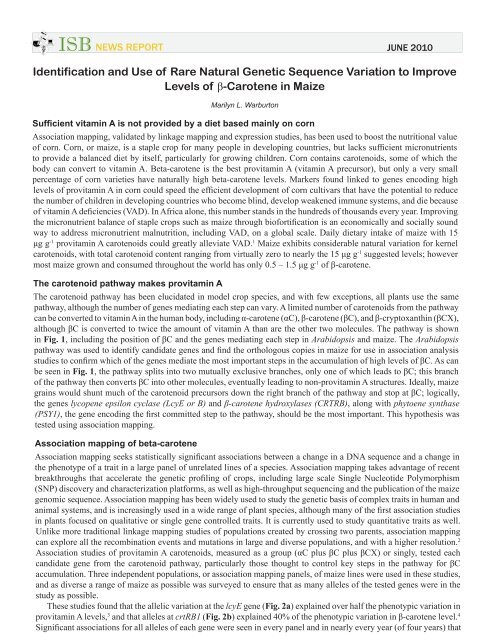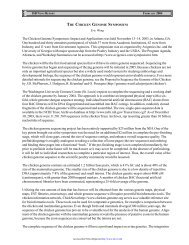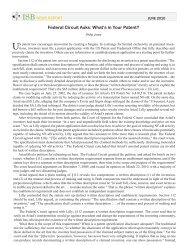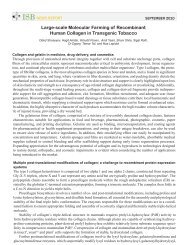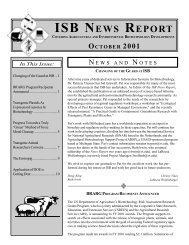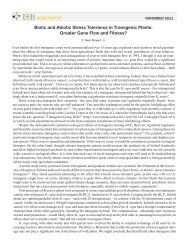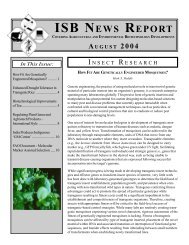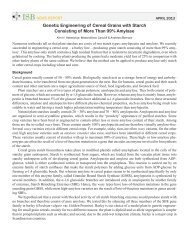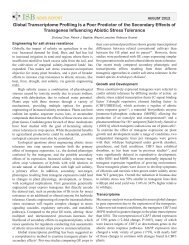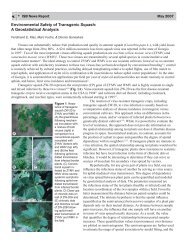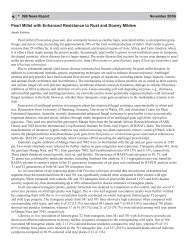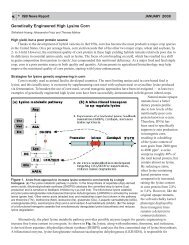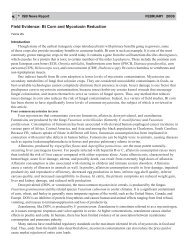Identification and Use of Rare Natural Genetic Sequence Variation ...
Identification and Use of Rare Natural Genetic Sequence Variation ...
Identification and Use of Rare Natural Genetic Sequence Variation ...
Create successful ePaper yourself
Turn your PDF publications into a flip-book with our unique Google optimized e-Paper software.
ISB NEWS REPORT JUNE 2010<br />
<strong>Identification</strong> <strong>and</strong> <strong>Use</strong> <strong>of</strong> <strong>Rare</strong> <strong>Natural</strong> <strong>Genetic</strong> <strong>Sequence</strong> <strong>Variation</strong> to Improve<br />
Levels <strong>of</strong> β-Carotene in Maize<br />
Marilyn L. Warburton<br />
Sufficient vitamin A is not provided by a diet based mainly on corn<br />
Association mapping, validated by linkage mapping <strong>and</strong> expression studies, has been used to boost the nutritional value<br />
<strong>of</strong> corn. Corn, or maize, is a staple crop for many people in developing countries, but lacks sufficient micronutrients<br />
to provide a balanced diet by itself, particularly for growing children. Corn contains carotenoids, some <strong>of</strong> which the<br />
body can convert to vitamin A. Beta-carotene is the best provitamin A (vitamin A precursor), but only a very small<br />
percentage <strong>of</strong> corn varieties have naturally high beta-carotene levels. Markers found linked to genes encoding high<br />
levels <strong>of</strong> provitamin A in corn could speed the efficient development <strong>of</strong> corn cultivars that have the potential to reduce<br />
the number <strong>of</strong> children in developing countries who become blind, develop weakened immune systems, <strong>and</strong> die because<br />
<strong>of</strong> vitamin A deficiencies (VAD). In Africa alone, this number st<strong>and</strong>s in the hundreds <strong>of</strong> thous<strong>and</strong>s every year. Improving<br />
the micronutrient balance <strong>of</strong> staple crops such as maize through bi<strong>of</strong>ortification is an economically <strong>and</strong> socially sound<br />
way to address micronutrient malnutrition, including VAD, on a global scale. Daily dietary intake <strong>of</strong> maize with 15<br />
μg g -1 provitamin A carotenoids could greatly alleviate VAD. 1 Maize exhibits considerable natural variation for kernel<br />
carotenoids, with total carotenoid content ranging from virtually zero to nearly the 15 μg g -1 suggested levels; however<br />
most maize grown <strong>and</strong> consumed throughout the world has only 0.5 – 1.5 μg g -1 <strong>of</strong> β-carotene.<br />
The carotenoid pathway makes provitamin A<br />
The carotenoid pathway has been elucidated in model crop species, <strong>and</strong> with few exceptions, all plants use the same<br />
pathway, although the number <strong>of</strong> genes mediating each step can vary. A limited number <strong>of</strong> carotenoids from the pathway<br />
can be converted to vitamin A in the human body, including α-carotene (αC), β-carotene (βC), <strong>and</strong> β-cryptoxanthin (βCX),<br />
although βC is converted to twice the amount <strong>of</strong> vitamin A than are the other two molecules. The pathway is shown<br />
in Fig. 1, including the position <strong>of</strong> βC <strong>and</strong> the genes mediating each step in Arabidopsis <strong>and</strong> maize. The Arabidopsis<br />
pathway was used to identify c<strong>and</strong>idate genes <strong>and</strong> find the orthologous copies in maize for use in association analysis<br />
studies to confirm which <strong>of</strong> the genes mediate the most important steps in the accumulation <strong>of</strong> high levels <strong>of</strong> βC. As can<br />
be seen in Fig. 1, the pathway splits into two mutually exclusive branches, only one <strong>of</strong> which leads to βC; this branch<br />
<strong>of</strong> the pathway then converts βC into other molecules, eventually leading to non-provitamin A structures. Ideally, maize<br />
grains would shunt much <strong>of</strong> the carotenoid precursors down the right branch <strong>of</strong> the pathway <strong>and</strong> stop at βC; logically,<br />
the genes lycopene epsilon cyclase (LcyE or B) <strong>and</strong> β-carotene hydroxylases (CRTRB), along with phytoene synthase<br />
(PSY1), the gene encoding the first committed step to the pathway, should be the most important. This hypothesis was<br />
tested using association mapping.<br />
Association mapping <strong>of</strong> beta-carotene<br />
Association mapping seeks statistically significant associations between a change in a DNA sequence <strong>and</strong> a change in<br />
the phenotype <strong>of</strong> a trait in a large panel <strong>of</strong> unrelated lines <strong>of</strong> a species. Association mapping takes advantage <strong>of</strong> recent<br />
breakthroughs that accelerate the genetic pr<strong>of</strong>iling <strong>of</strong> crops, including large scale Single Nucleotide Polymorphism<br />
(SNP) discovery <strong>and</strong> characterization platforms, as well as high-throughput sequencing <strong>and</strong> the publication <strong>of</strong> the maize<br />
genomic sequence. Association mapping has been widely used to study the genetic basis <strong>of</strong> complex traits in human <strong>and</strong><br />
animal systems, <strong>and</strong> is increasingly used in a wide range <strong>of</strong> plant species, although many <strong>of</strong> the first association studies<br />
in plants focused on qualitative or single gene controlled traits. It is currently used to study quantitative traits as well.<br />
Unlike more traditional linkage mapping studies <strong>of</strong> populations created by crossing two parents, association mapping<br />
can explore all the recombination events <strong>and</strong> mutations in large <strong>and</strong> diverse populations, <strong>and</strong> with a higher resolution. 2<br />
Association studies <strong>of</strong> provitamin A carotenoids, measured as a group (αC plus βC plus βCX) or singly, tested each<br />
c<strong>and</strong>idate gene from the carotenoid pathway, particularly those thought to control key steps in the pathway for βC<br />
accumulation. Three independent populations, or association mapping panels, <strong>of</strong> maize lines were used in these studies,<br />
<strong>and</strong> as diverse a range <strong>of</strong> maize as possible was surveyed to ensure that as many alleles <strong>of</strong> the tested genes were in the<br />
study as possible.<br />
These studies found that the allelic variation at the lcyE gene (Fig. 2a) explained over half the phenotypic variation in<br />
provitamin A levels, 3 <strong>and</strong> that alleles at crtRB1 (Fig. 2b) explained 40% <strong>of</strong> the phenotypic variation in β-carotene level. 4<br />
Significant associations for all alleles <strong>of</strong> each gene were seen in every panel <strong>and</strong> in nearly every year (<strong>of</strong> four years) that
ISB NEWS REPORT JUNE 2010<br />
the traits were measured. Previous sequencing studies have also confirmed the role <strong>of</strong> the psy1 gene in the carotenoid<br />
pathway, 5 where it behaves as a single gene controlling the presence or absence <strong>of</strong> any carotenoids. Once the carotenoid<br />
pathway has been activated, it is significant that haplotypes in just two more genes explain most <strong>of</strong> the phenotypic<br />
variation in the levels <strong>of</strong> carotenoid <strong>and</strong> βC levels, traits showing continuous variation, <strong>and</strong> this is very promising for the<br />
ability to generate high βC maize lines via Marker Assisted Selection (MAS).<br />
The combined effects on βC concentrations <strong>of</strong> one main functional polymorphism (allele) <strong>of</strong> lcyE (5′TE, Fig. 2a) <strong>and</strong><br />
two <strong>of</strong> crtRB1 (5′TE <strong>and</strong>/or 3′TE, Fig. 2b) were analyzed in the three association panels. These polymorphisms were<br />
chosen because they had the highest estimated phenotypic effects <strong>and</strong> were physically farthest away from each other on<br />
the chromosomes, thus avoiding the confounding effect <strong>of</strong> linkage on the analysis. A greater proportion <strong>of</strong> the phenotypic<br />
variation in βC <strong>and</strong> the ratio <strong>of</strong> βC to all other carotenoids (βC/ALL) (52% <strong>and</strong> 65%, respectively) was explained by<br />
the combined crtRB1/lcyE polymorphisms than by those <strong>of</strong> either gene alone. Combined lcyE <strong>and</strong> crtRB1 effects at<br />
each polymorphism were largely additive. No inbred haplotype in the association panels combined the most favorable<br />
haplotypes for crtRB1 5′TE, crtRB1 3′TE, <strong>and</strong> lcyE 5′TE, which is a problem when searching for specific combinations<br />
<strong>of</strong> several alleles simultaneously, unless a prohibitively large association mapping panel is used. However, between the<br />
existing common haplotypes predicted to yield the most <strong>and</strong> least βC, there was a 12-fold difference in βC concentration<br />
<strong>and</strong> nearly a 20-fold difference in βC/ALL in two <strong>of</strong> the three association mapping panels. The third panel was not<br />
polymorphic for one <strong>of</strong> the alleles <strong>and</strong> could not be included in the analysis, which is one advantage <strong>of</strong> using multiple<br />
panels. Increases in βC <strong>and</strong> provitamin A derived from the more favorable haplotype in the two panels averaged 5.91 <strong>and</strong><br />
5.65 μg g -1 , or nearly 40% <strong>of</strong> the goal <strong>of</strong> nutritional breeders for human health.<br />
Figure 1: Simplified carotenoid biosynthetic<br />
pathway in maize <strong>and</strong> Arabidopsis.<br />
CRTRB, in blue, represents the<br />
nonheme di-iron β-carotene hydroxylase<br />
(BCH) family in maize, which has at least<br />
five members; the orthologous family in<br />
Arabidopsis has two members (BCH1 <strong>and</strong><br />
BCH2). Carotenoid intermediates highlighted<br />
in red were measured by HPLC for<br />
association studies. GGPP, geranylgeranyl<br />
pyrophosphate; PSY, phytoene synthase;<br />
PDS, phytoene desaturase; Z-ISO,<br />
ζ-carotene isomerase; ZDS, ζ-carotene desaturase;<br />
CRTISO, carotenoid isomerase;<br />
LCYE, lycopene ε-cyclase; LCYB, lycopene<br />
β-cyclase; CRTRB, β-carotene hydroxylase<br />
family; CYP97A, β-carotene hydroxylase<br />
(P450); CYP97C, ε-carotene hydroxylase<br />
(P450); ZEP1, zeaxanthin epoxidase;<br />
VDE1, violaxanthin de-epoxidase; ABA,<br />
abscisic acid.<br />
Figure 2a: Polymorphisms significantly associated with carotenoid phenotypes in<br />
Zea 4 LcyE. Putative promoters are depicted as orange arrows, exons as black squares, <strong>and</strong><br />
the sampled regions as gray boxes. Polymorphisms that significantly associated with changes<br />
in flux between the lutein (left) <strong>and</strong> zeaxanthin (right) branches <strong>of</strong> the pathway in Figure 1 are<br />
labeled with asterisks. The 5’ transposable element insertion(s) are represented by the white<br />
triangles. Positions relative to the sequence alignment are indicated numerically above the<br />
polymorphisms.
ISB NEWS REPORT JUNE 2010<br />
Figure 2b: Polymorphisms significantly associated with carotenoid phenotypes in Zea mays crtRB1. The sequenced region<br />
is framed in gray, translated exons are depicted as black boxes <strong>and</strong> the putative start <strong>of</strong> transcription (TSS) <strong>and</strong> poly(A) sites are indicated.<br />
Polymorphisms found in one association mapping panel are marked in the diagram, <strong>and</strong> those that are significantly associated with changes in<br />
βC, βC/βCX, βC/Z <strong>and</strong> βC/ALL are labeled with asterisks; abbreviations are the same as in Figure 1.<br />
QTL mapping to confirm the role <strong>of</strong> the two genes on beta-carotene levels<br />
The phenotypic effects <strong>of</strong> both genes on different carotenoid levels (particularly on the desired trait, βC) were confirmed<br />
by linkage mapping. The lcyE gene mapped to chromosome 8 bin 5 in a QTL mapping population from B73 × Mo17,<br />
where it co-localized with a previously mapped QTL that had no known underlying c<strong>and</strong>idate gene. This QTL showed<br />
significant effects for modification <strong>of</strong> the ratio <strong>of</strong> the left <strong>and</strong> right branch carotenoids <strong>and</strong> explained 31.7% <strong>of</strong> the<br />
variation for lutein. 6 This QTL was not significant for total carotenoids, which further supports the conclusion that<br />
variation within the lcyE gene underlies this QTL for carotenoid composition, since it influences the type <strong>of</strong> carotenoid,<br />
rather than total amount.<br />
QTL mapping <strong>of</strong> crtRB1 was carried out in three recombinant inbred lines (RILs) populations. 3 In all populations,<br />
crtRB1 mapped to a genetic interval containing a principal QTL for βC concentration <strong>and</strong> βC/ALL, explaining 16.3%<br />
<strong>and</strong> 32.8% <strong>of</strong> the trait variation, respectively. Favorable homozygous genotypes in the three mapping populations led<br />
to β-carotene increases <strong>of</strong> 2.78 μg g -1 , 1.61 μg g -1 , <strong>and</strong> 0.53 μg g -1 over βC concentrations <strong>of</strong> the respective unfavorable<br />
homozygotes, which averaged 2.79, 0.76, <strong>and</strong> 4.62 μg g -1 . Collectively, these results indicate that favorable crtRB1 alleles<br />
can lead to higher βC concentrations across a range <strong>of</strong> segregating genetic backgrounds.<br />
Expression analysis confirms the role <strong>of</strong> the two genes on beta-carotene levels<br />
Expression analysis indicated that lcyE is preferentially expressed in the endosperm relative to the embryo. 2 Expression<br />
pr<strong>of</strong>iling <strong>of</strong> kernels at 15 <strong>and</strong> 20 days after pollination (DAP) indicated that expression levels correlated well with the ratio<br />
<strong>of</strong> carotenoids from each pathway branch, explaining 70 to 76% <strong>of</strong> the variance. Lines with transposon insertions near the<br />
start site (Fig. 2b) had much lower expression levels (in 15 <strong>and</strong> 20 DAP, lower by a factor <strong>of</strong> 3.7 <strong>and</strong> 13, respectively).<br />
crtRB1 transcripts from kernels harvested 15 DAP in six inbred lines (A619, B77, CI7, Hi27, NC320, <strong>and</strong> NC356),<br />
which varied by an order <strong>of</strong> magnitude in their seed βC concentration, were examined. 3 In lines containing relatively high<br />
concentrations <strong>of</strong> βC (CI7 <strong>and</strong> B77; identical crtRB1 haplotypes), crtRB1 transcripts accumulated to only 1/70 <strong>of</strong> the<br />
level <strong>of</strong> crtRB1 transcripts in lines with low βC concentrations (NC356, Hi27, <strong>and</strong> NC320). Relative to all tested lines,<br />
transcript <strong>and</strong> βC concentrations were both intermediate in A619, which carries only the 3′TE insertion (Fig. 2b). This<br />
implies that polymorphisms associated with 5′TE, 3′TE, <strong>and</strong> InDel4 result in substantial transcript reduction in kernels<br />
<strong>and</strong> probably decrease β-hydroxylase activity through reduction <strong>of</strong> CRTRB1 protein levels. The differences in expression<br />
levels were very high in endosperm, not very different in embryos, <strong>and</strong> not at all different in leaves, which suggest tissuespecific<br />
regulation <strong>of</strong> crtRB1. This is important <strong>and</strong> encouraging, as the carotenoid pathway later leads into the ABA<br />
pathway, <strong>and</strong> stopping the production <strong>of</strong> carotenoids at βC could conceivably cause problems for the germinating embryo<br />
or the maize plant, which requires ABA to properly respond to developmental <strong>and</strong> environmental growth signals.<br />
Markers from two genes speed breeding progress for high beta-carotene maize lines<br />
Inexpensive PCR-based markers were developed to differentiate all alleles <strong>of</strong> the two genes for use in MAS. The favorable
ISB NEWS REPORT JUNE 2010<br />
alleles for both genes are rare in most maize germplasm <strong>and</strong> are especially rare in tropically adapted maize cultivars, which<br />
are urgently needed to express high levels <strong>of</strong> βC if they are to benefit the people who need them most. Through the use<br />
<strong>of</strong> donor lines <strong>and</strong> user-friendly PCR-based marker systems, introgression <strong>of</strong> the most favorable crtRB1 <strong>and</strong> lcyE alleles<br />
into tropical germplasm has already achieved provitamin A target concentrations <strong>of</strong> 15 μg g -1 in preliminary evaluations<br />
<strong>of</strong> breeding lines (data not shown), <strong>and</strong> the use <strong>of</strong> these markers in applied breeding programs throughout the world will<br />
quickly bring more highly nutritious, well-adapted maize cultivars to farmers.<br />
Concluding remarks<br />
Pr<strong>of</strong>iling techniques <strong>of</strong>fer a multidisciplinary approach to the safety assessment <strong>of</strong> GE plants, <strong>and</strong> provide a rigorous<br />
scientific basis for the identification <strong>of</strong> any possible unintended health effect that could arise from genetic engineering. In<br />
this study non-targeted molecular pr<strong>of</strong>iling technologies were used to provide insight into the extent <strong>of</strong> variation in the<br />
maize transcriptome, proteome, <strong>and</strong> metabolome by analyzing three maize genotypes, two <strong>of</strong> them transgenic, grown in<br />
the same location over three years/growing seasons. The observed variation was caused mainly by growing season, with<br />
the associated environmental factors, <strong>and</strong> not due to genotype. Even though the environment was the dominant source<br />
<strong>of</strong> variation, no common drivers <strong>of</strong> variation were identified.<br />
This study also highlights the possibilities as well as the challenges <strong>of</strong> pr<strong>of</strong>iling analysis for food safety evaluation. A<br />
big challenge <strong>of</strong> the ‘omics’ technologies is the vast amount <strong>of</strong> data generated, making it extremely complex to evaluate<br />
individual GE lines <strong>and</strong> difficult to form a meaningful interpretation. Other challenges include the many gaps related to<br />
the number <strong>of</strong> genes for which a function has been identified <strong>and</strong> the limited coverage <strong>of</strong> the proteome <strong>and</strong> metabolome.<br />
Furthermore these technologies should not be limited to the safety assessment <strong>of</strong> GE-derived crops, which are already<br />
subjected to extensive <strong>and</strong> costly pre-market analysis, but should be extended to plant varieties improved by mutagenesis.<br />
Mutagenised rice plants are reported to have more changes in their transcript pr<strong>of</strong>iles than genetic engineered rice plants,<br />
even though changes in the transcriptome do not necessarily correlate with risk; proteomic studies need to be performed<br />
to provide information on the nature <strong>of</strong> the proteins. 5 These technologies still need to be validated before they can be<br />
used on a case-by-case basis to confirm or supplement the current targeted analytical approaches. They are not intended<br />
to replace existing analyses, but they may trigger the need for a more detailed <strong>and</strong> targeted analysis <strong>of</strong> specific groups <strong>of</strong><br />
genes, proteins, <strong>and</strong> metabolites.<br />
References<br />
1.<br />
2.<br />
3.<br />
4.<br />
5.<br />
Pfeiffer WH & McClafferty B. ( 2007) HarvestPlus: breeding crops for better nutrition. Crop Sci. 47, S88–S105<br />
Yu J, & Buckler ES. (2006) <strong>Genetic</strong> association mapping <strong>and</strong> genome organization <strong>of</strong> maize. Curr. Opin. Biotech. 17, 155–160<br />
Harjes CE, et al. (2008) <strong>Natural</strong> genetic variation in lycopene epsilon cyclase tapped for maize bi<strong>of</strong>ortification. Science 319, 330–333<br />
Yan J, et al. (2010) <strong>Rare</strong> genetic variation at Zea mays crtRB1 increases β-carotene in maize grain. Nature <strong>Genetic</strong>s doi:10.1038/ng.551<br />
Palaisa K, et al. (2004) Long-range patterns <strong>of</strong> diversity <strong>and</strong> linkage disequilibrium surrounding the maize Y1 gene are indicative <strong>of</strong> an asymmetric selective<br />
sweep. Proc Natl Acad Sci USA 101, 9885–9890<br />
6. Wong JC, et al. (2004) QTL <strong>and</strong> c<strong>and</strong>idate genes phytoene synthase <strong>and</strong> ζ -carotene desaturase associated with the accumulation <strong>of</strong> carotenoids in<br />
maize. Theor. Appl. Genet. 108, 349<br />
Marilyn L. Warburton<br />
USDA ARS Corn Host Plant Research Resistance Unit<br />
Mississippi State University, MS 39759<br />
Marilyn.warburton@ars.usda.gov


